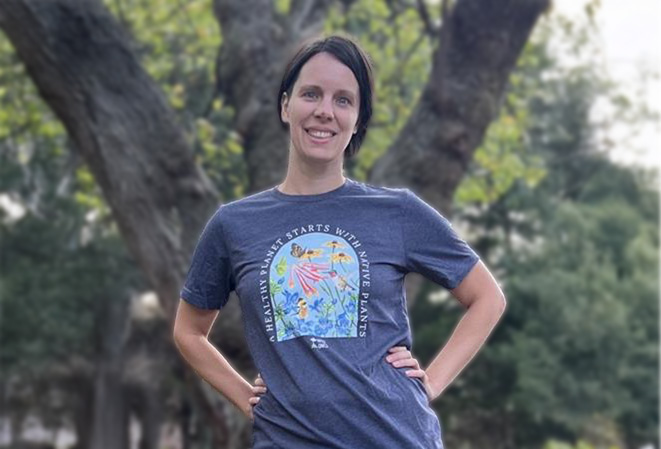At Wild Ones, we’re dedicated to connecting people and native plants. Our Native Plant News blog delivers the latest stories on native plant conservation, scientific discoveries, and habitat restoration from across the nation. This monthly, volunteer-written feature is designed to educate, engage, and inspire action, empowering readers to support biodiversity and promote sustainable landscaping with native flora.
Rhode Island: Creating habitat for the birds and the bees
The Norman Bird Sanctuary is transforming its 300-acre Coastal Field from a former agricultural field dominated by invasive plants into one of the largest pollinator habitats in the state.
The project began with controlled burns to remove multiflora rose (Rosa multiflora), privet (Ligustrum spp.), and porcelain berry (Ampelopsis glandulosa). Staff and volunteers pulled any stubborn remaining plants after the burns. Non-invasive vegetation was spread over the burned field to improve the soil. Native plants, such as northern bayberry (Myrica pensylvanica), that are not suited for the meadow being planned were moved to other parts of the sanctuary. In June, buckwheat will be planted to smother out any germinated invasive plants and then cut back before it flowers. A pollinator seed mix will then be planted and yearly maintenance of mowing and invasive species removal is planned.
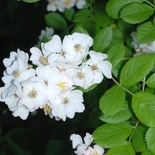
Multiflora Rose(Rosa multiflora)
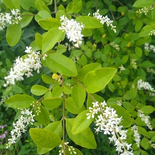
Privet(Ligustrum spp.)
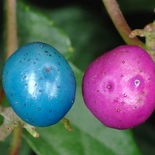
Porcelain Berry(Ampelopsis brevipedunculata)
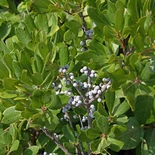
Northern Bayberry(Morella pensylvanica)
The sanctuary hopes that this project, funded by the Natural Resources Conservation Service, will provide more habitat for grassland birds such as the bobolink (Dolichonyx oryzivorus). “It was a grassland. It was a field. We’re trying to restore it back to its original history. We want to address the need for better pollination, protection, and habitat for different species,” said Joye Whitney, director of horticulture and conservation for the Norman Bird Sanctuary.
Bird sanctuary burns down invasive plants to create native habitat – ecoRI News
Wyoming: Celebrating Native Plant Month
April is “Wyoming Native Plant Month”, according to a proclamation signed by governor, Mark Gordon, and residents are recognizing and celebrating Wyoming’s biological heritage by planting native trees, shrubs, and flowers, removing non-native invasive plants, and educating the public on the benefits of native plants.
The Wyoming Native Plant Society is inviting poster entries from 6th to 8th graders with the theme “Wyoming Native Plants and Pollinators: Better Together”, demonstrating the connection between specific species of native plants and pollinators. Winning entries get a cash prize and will be featured on the society’s website, social media, and displayed at local libraries.
Over 2,500 native plant species, more than 700 bee species, and many other pollinators are found in Wyoming.
Celebrate your native plants – Sundance Times
Where are the native plants?
Dark diversity, a term referring to species that are missing from an ecosystem even if the habitat is suitable for the species, is an important, and relatively recent, concept in understanding biodiversity and is being incorporated into ecological research. Instead of just counting the species found in an area, scientists are now counting the species that could live in an area but don’t.
A recent study published this month in the journal Nature, examined the scale of dark diversity in thousands of sites worldwide. The team of 200 scientists found that in regions heavily affected by human activities, only 20% of native plants able to live in these regions were present. Surprisingly, in more pristine ecosystems, only 33% of plant species were found. Human impact, even from a distance, was likely still the culprit: poaching, logging, pollution, habitat fragmentation, and human-caused fires can still threaten species a distance away from human settlement. The loss of other species in the area, such as seed-spreading animals, can hinder the plant’s ability to repopulate habitat.
While the study’s findings were disheartening as to how much human activities affect biodiversity, it was observed that in areas where least ⅓ of the landscape had minimal human disturbance, there were fewer instances of hidden biodiversity loss. Understanding the scale of biodiversity loss by considering the dark diversity concept in population counts can guide restoration and conservation work to preserve the species that are left and bring back the species that are missing.
Iowa: Celebrating Arbor Day the Miyawaki Way
The University of Iowa is celebrating Arbor Day by planting 4,000 native tree seedlings on the west side of campus using the Miyawaki method reforestation technique.
The Miyawaki method is a planting technique of densely planting native seedlings, just 1-2 feet apart, to mimic the natural growth process of forests. Miyawaki forests mature in 20-30 years while conventional forests take centuries. Miyawaki forests also require only 3 years of weeding and watering with forests becoming mostly self-sustaining after that point.
A College of Engineering’s Sustainable Systems class learned about the Miyawaki method last fall. After determining that a Miyawaki forest could be planted on campus and presenting their findings to the University, the University decided to move forward with the plan. Landscape Services selected the site with a steep hill that was dangerous to mow so future construction was not realistic.
Once completed, the University of Iowa’s Miyawaki forest will be the largest Miyawaki forest, and the second one created, in the state of Iowa. Planting begins April 25th and volunteers are needed.
UI to plant campus forest inspired by student project – Iowa Now – The University of Iowa
Give the Heave-Ho to (Invasive) Honeysuckle
Non-native honeysuckle (Lonicera spp.), including Amur honeysuckle (L. maacki) is a widespread invasive plant, originally from Europe and Asia. One of the first plants to leaf out in the spring and the last to lose its leaves in the fall, these shrubs outcompete native plants by monopolizing nutrients and light. These honeysuckles also can grow in a wide range of temperatures, in shady and sunny locations, and in most soil types. Birds regularly eat their berries and spread the seeds widely.
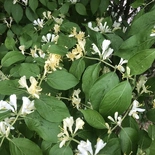
Amur Honeysuckle(Lonicera maackii)
Amur honeysuckle has been found to harm amphibian populations too. The honeysuckle’s leaf litter contains tannins which not only inhibit other plant growth but also alter the water chemistry where the leaf litter can accumulate. When that leaf litter decomposes in the water, the water oxygen content decreases. If the oxygen content in the water becomes too low, tadpole populations decline in response as they suffocate or are more vulnerable to predation as they are forced to the surface for air.
Amur honeysuckle and other invasive non-native honeysuckles should be removed. The early and late leafing out characteristics of these species make it easy to identify. Removing the plant can be done by pulling it up with its roots or cutting it and applying herbicide to the stump. Mowing is also a successful removal technique but it needs to be done for multiple growing seasons.
To the Editor: This honeysuckle has to go – Crozet Gazette
The ethnobotanical gardens of University of Georgia
Over 100 different plants used for thousands of years by North American and Latin indigenous cultures can be found at the Ethnobotanical gardens at the University of Georgia. All the plants at the gardens are edible or have medicinal or spiritual importance.
Preserving both plant and cultural knowledge is the goal of this garden. Signs with the Indigenous, the English translation and Latin names as well as the uses are displayed by each plant. Preserving indigenous cultures protects the traditions, wisdom, history, and human diversity. Plants also provide an important way of learning, and the formation of, the language of these cultures.
A Sure Sign of Spring: the Skunk Cabbage
The skunk cabbage (Symplocarpus foetidus) is the first flower to emerge in many parts of the United States. Like many spring ephemerals, its time to shine is brief and then it goes dormant by early summer, taking full advantage of the lack of competition and dappled sunlight.
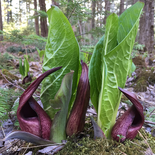
Skunk Cabbage(Symplocarpus foetidus)
The skunk cabbage rises just inches from the ground and as it emerges, it looks like a bulb. This wetland plant is also able to generate its own heat and can melt snow as it emerges. Finally, the plant’s namesake comes from the rotting flesh smell that attracts flies and other insects attracted to carrion, which then pollinate this plant. The “cabbage” part of this plant’s name comes from the large cabbage-shaped leaves that emerge after it blooms.
Canada: Finding Native Plants a New Home
The Friends of Fish Creek Provincial Park Society is restoring Fish Creek Provincial Park using native plants rescued from development sites. In partnership with Alberta Native Plant Rescue, the group rescued over 15,000 plants last year from being lost to development. Most (80%) of these plants were relocated to Fish Creek Provincial Park, the rest were given to the public and a nursery to supply the park with plants in the future.
This year the group is working with three developers to rescue plants before construction occurs. “Because we’re going to multiple different salvage sites, we’re taking plants from all across these areas. We’re able to put them in the park and have this really incredible diversity of species as well as individual genetics,” Katrina Terrill, the society’s executive director said. “That’s much healthier for the ecosystem in total.” Genesis Land Development Corporation, one of the developers, is planning to share seed with homeowners moving into the community.
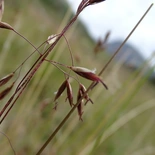
Altai Fescue(Festuca altaica)
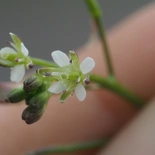
Longrunner(Rorippa sarmentosa)
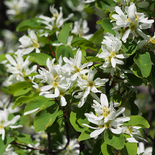
Saskatoon Serviceberry(Amelanchier alnifolia)
Less than 1% of the native grasslands that once comprised the Fish Creek Provincial Park remain. The plants being rescued from development like rough fescue (Festuca altaica) , oat grass (Poaceae), wild rose (Rosa spp.), Saskatoon berries (Amelanchier alnifolia), and sage grass (Artemisia tridentata) will help restore the park. Trees and shrubs are also being planted along the creek to stabilize the bank and create shade for fish. “We’re really looking to restore the whole diversity of the grasslands, not just one or two species,” Terrill said.
Group saves native plants from being bulldozed, gives them 2nd chance in Fish Creek Park – CBC News

